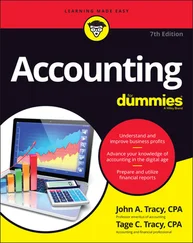The income statement and balance sheet for the company example introduced in Chapter 1are presented here in Exhibits 2.1and 2.2, respectively. The format and content of these two financial statements apply to manufacturers, wholesalers, and retailers—businesses that make or buy products that are sold to their customers. Although the financial statements of service businesses that don’t sell products differ somewhat, Exhibits 2.1and 2.2illustrate the basic framework and content of income statements and balance sheets for all businesses.
EXHIBIT 2.1 INCOME STATEMENT FOR YEAR
| Dollar Amounts in Thousands |
| Sales Revenue |
$ 52,000) |
| Cost of Goods Sold Expense |
(33,800) |
| Gross Margin |
$ 18,200) |
| Selling, General, and Administrative Expenses |
(12,480) |
| Depreciation Expense |
(785) |
| Earnings Before Interest and Income Tax |
$ 4,935) |
| Interest Expense |
(545) |
| Earnings Before Income Tax |
$ 4,390) |
| Income Tax Expense |
(1,748) |
| Net Income |
$ 2,642) |
EXHIBIT 2.2 YEAR-END BALANCE SHEETS
| Dollar Amounts in Thousands |
|
Last Year-End) |
This Year-End) |
Change) |
| Cash) |
$ 3,735) |
$ 3,265) |
$0(470) |
| Accounts Receivable) |
4,680) |
5,000) |
320) |
| Inventory) |
7,515) |
8,450) |
935) |
| Prepaid Expenses) |
685) |
960) |
275) |
| Current Assets) |
$ 16,615) |
$ 17,675) |
|
| Property, Plant, and Equipment) |
$ 13,450) |
$ 16,500) |
3,050) |
| Accumulated Depreciation) |
(3,465)) |
(4,250)) |
(785) |
| Cost Less Depreciation) |
$ 9,985) |
$ 12,250) |
|
| Intangible Assets) |
$ 5,000) |
$ 5,575) |
575) |
| Long-Term Operating Assets) |
$ 14,985) |
$ 17,825) |
|
| Total Assets) |
$ 31,600) |
$ 35,500) |
$ 3,900) |
| Accounts Payable) |
$ 2,675) |
$ 3,320) |
$ 645) |
| Accrued Expenses Payable) |
1,035) |
1,515) |
480) |
| Income Tax Payable) |
82) |
165) |
83) |
| Short-Term Notes Payable) |
3,000) |
3,125) |
125) |
| Current Liabilities) |
$ 6,792) |
$ 8,125) |
|
| Long-Term Notes Payable) |
$ 3,750) |
$ 4,250) |
500) |
| Capital Stock—793,000 shares and 800,000 shares respectively) |
$ 7,950) |
$ 8,125) |
175) |
| Retained Earnings) |
13,108) |
15,000) |
1,892) |
| Stockholders’ Equity) |
$ 21,058) |
$ 23,125) |
|
| Total Liabilities and Stockholders’ Equity) |
$ 31,600) |
$ 35,500) |
$ 3,900) |
Reporting Profit Performance: The Income Statement
The first question on everyone’s mind is usually whether a business made a profit or suffered a loss and how much. Also, people are interested in the size of the business, which usually refers to the annual sales revenue. The income statement summarizes sales revenue and expenses for a period of time (one year in Exhibit 2.1). All the dollar amounts reported in this financial statement are cumulative totals for the whole period.
The top line identifies the total amount of proceeds or gross income from sales to customers, and is generally called sales revenue . The bottom line reflects net income (also sometimes called net earnings , but seldom profit or net profit ). Net income is the final profit after all expenses are deducted from sales revenue. The business in this example earned $2,642,000 net income on its sales revenue of $52,000,000 for the year. In other words, after deducting all expenses, only a smidgeon more than 5 percent of the company’s sales revenue remained as final profit (net income).
The income statement is read in a step-down manner, like walking down stairs. Each step down is a deduction of one or more expenses. The first step deducts the cost of goods (products) sold from the sales revenue of goods sold, which gives gross margin. (Note that gross margin is also called gross profit , which is one of the few terms on an income statement that contains the word profit. ) This measure of profit is called gross because many other expenses have not yet been deducted.
Next, two additional expense deductions are made. The first is selling, general , and administrative expenses , which is a broad category of operating expenses. The second is the depreciation expense (a unique expense). Both of these are deducted from gross margin, giving earnings before interest and income tax . This measure of profit is also called operating earnings (which sometimes goes by a slightly different name). Next, interest expense on debt is deducted, which gives earnings before income tax. The last step is to deduct income tax expense, which gives net income, which appears on the bottom line on the income statement. Undoubtedly, you’ve heard the term “bottom line,” and the placement of net income on the income statement is where it comes from. (However, this slang is not used in financial reports.)
As an aside, note that you may hear the income statement called a profit and loss or P&L statement . This title is not used in external financial reports released outside the business.
Exhibit 2.1depicts a multiple-step income statement, which shows three intermediate measures of profit. Exhibit 2.3depicts a single-step income statement. The single-step format reports only the final line of net income instead of calculating it various times along the way.
EXHIBIT 2.3 SINGLE-STEP INCOME STATEMENT
| Dollar Amounts in Thousands |
| Sales Revenue |
$ 52,000) |
| Cost of Goods Sold Expense |
$ (33,800) |
| Selling, General, and Administrative Expenses |
$ (12,480) |
| Depreciation Expense |
$ (785) |
| Interest Expense |
$ (545) |
| Income Tax Expense |
$ (1,748) |
| Net Income |
$ 2,642) |
Publicly owned business corporations are required to report earnings per share (EPS), which is basically the annual net income divided by the number of capital stock shares. Privately owned businesses don’t have to report EPS, but this figure may be useful to their stockholders. We explain earnings per share in Chapter 13.
In our income statement example ( Exhibit 2.1) you see five different expenses. You may find more expense lines in an income statement, but there would seldom be more than 10 or so, as a general rule. (There can be exceptions if a business has a very unusual year.) One expense that companies are required to report is cost of goods sold. Depreciation, another expense, is so unique that we prefer to report it on a separate line, but some companies do not do this. However, depreciation can be included in another operating expense in the income statement instead of being reported separately.
Читать дальше












